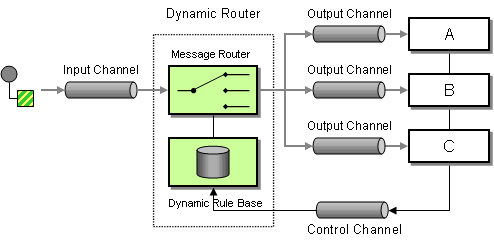8.18. 动态路由器
动态路由器
如 图 8.12 “动态路由器模式” 所示,动态路由器 模式允许您通过一系列处理步骤连续路由消息,其中设计时不已知步骤序列。在运行时动态计算消息的端点列表。每次消息从端点返回时,在 bean 上返回动态路由器调用,以便在路由中发现下一个端点。
图 8.12. 动态路由器模式
在 Camel 2.5 中,我们在 DSL 中引入了一个动态 路由器,类似于评估 slip on-fly 的动态 第 8.7 节 “路由 Slip”。
您必须确保用于 dynamicRouter 的表达式(如 bean)返回 null 以表示结尾。否则,dynamicRouter 会继续进行无限循环。
Camel 2.5 中的动态路由器开始
从 Camel 2.5 中,第 8.18 节 “动态路由器” 更新交换属性 Exchange.SLIP_ENDPOINT,其当前的端点通过 slip 推进。这可让您了解交换是通过 slip 进行的。(它是滑动,因为 第 8.18 节 “动态路由器” 的实现基于 第 8.7 节 “路由 Slip”。)
Java DSL
在 Java DSL 中,您可以使用 动态Router,如下所示:
from("direct:start")
// use a bean as the dynamic router
.dynamicRouter(bean(DynamicRouterTest.class, "slip"));
from("direct:start")
// use a bean as the dynamic router
.dynamicRouter(bean(DynamicRouterTest.class, "slip"));它们利用 bean 集成来计算滑动 ( fly )上的,该集成可以按以下方式实施:
前面的示例 不是 线程安全。您必须将状态存储在 Exchange 上,以确保线程安全。
Spring XML
与 Spring XML 中的相同示例是:
选项
dynamicRouter DSL 命令支持以下选项:
| 名称 | 默认值 | 描述 |
|
|
| 第 II 部分 “路由表达式和指定语言” 返回多个端点时使用的分隔符。 |
|
|
| 如果无法解析 endpoint uri,它应该被忽略。否则,Camel 会抛出一个异常,说明 endpoint uri 无效。 |
@DynamicRouter annotation
您还可以使用 @DynamicRouter 注释。例如:
路由 方法会在消息通过 slip 时重复调用。其理念是返回下一个目的地的端点 URI。返回 null 以表示结尾。如果您像 第 8.7 节 “路由 Slip” 一样,您可以返回多个端点,其中每个端点通过分隔符分隔。
